#Cooking methods inflammation
Explore tagged Tumblr posts
Text
Foods that fight inflammation
Foods that fight inflammation : A Anti-Inflammatory Adventure: A Personal Journey As a healthy food advocate, I’m always looking to practice what I preach, always on the hunt for the next big story in health and wellness, on my top hit list is fighting inflammation. So, I decided to embark on a personal journey to explore foods that fight inflammation. “Foods that fight inflammation”: Armed with…

View On WordPress
#Anti-inflammatory cooking#Anti-inflammatory diet#Anti-inflammatory foods#Anti-inflammatory meal plan#Apple cider vinegar inflammation#Best foods for inflammation#Cooking methods inflammation#Fermented foods inflammation#Foods that fight inflammation#Foods to reduce inflammation#Ginger for inflammation#Green tea inflammation#Gut health and inflammation#Inflammation reducing foods#Japanese diet for inflammation#Nordic diet benefits#Olive oil anti-inflammatory#Probiotic foods for inflammation#Reduce inflammation
2 notes
·
View notes
Text
Let’s Chat About Eggs and What Barbara O’Neill Has to Say!
Hey there! So, I’ve been hearing some buzz lately about eggs—yep, those little protein-packed wonders we all love—and some surprising advice from Barbara O’Neill. She’s been saying there are certain foods you should never eat with eggs because they could mess with your health. But is she onto something, or is this just another health trend we should take with a grain of salt? I dug into this a…
#Barbara O’Neill#cooking methods#diet#diet tips#Eggs#fitness#food#health#healthy eating#inflammation#nutrient absorption#nutrition
0 notes
Note
Oma. Oma. How dare you let it drop that you make delicious soup every week and not share your methods/recipes? (/lh)
Okay but legit though may we have the Oma soup insights? 🥺🙏 Do you have favortie recipes? Soup bases or methods you'd recommend? Favorite parings of veggies and/or other ingredients that tend to taste good together (i.e. cheddar and broccoli)? Anything else you'd discovered about soup or making soup at you'd like to share? Please <3
LOL I'm so sorry, I didn't realize there were so many soup lovers here!! (As there should be😌😉)
Ah yes, my soup making secrets..

Ok, so Im afraid my methods are kinda chaos😅 I legitimately throw in whatever veggies and protein I have on hand and season with my heart
I also don't eat grains or dairy in my day-to-day (not intolerant, just helps with inflammation) so I don't do a lot of cream based soups. But here's some things I've found!
Red Boat fish Sauce has a really good umami flavor that you can add to your broths! Doesn't taste fishy AT ALL.
if you've already salted your food but it still tastes like you could use salt, try adding lemon or lime juice. It adds SO much that salt can't.
Potato starch is a great non-flour/gluten way to thinken your soup base! Just don't forget to make a slurry so it doesn't clump
Coconut cream or soaked,blended cashews can be a really good dairy substitute. The flavor isn't really the same, but it adds a creaminess that dairy does.
Don't underestimate the power of bouillon cubes. Oh and I use the chicken juices that come out during the cooking process as broth for extra flavor.
Immersion blenders (or blenders in general) are GREAT if you want a creamy soup but don't want dairy or flour to thicken it. I like to blend squash and potatoes for those kinds of soups
And now, a tier of my favorite soups:
My mom's chicken noodle soup (hers specifically)
Sausage and sauerkraut soup
Whole 30 Chicken Pot Pie soup
Chili
I often use Pinterest as a guide if I want to use specific ingredients (I made a spring onion soup once cus I was given like, 15 bundles of them)
Often tho i just make different variations of vegetable soup and throw in some chicken. It's nothing life changing but it usually tastes pretty good haha
What are your favorite soups?? You have your own tips and tricks???!
#i hope this helps in your soupy endeavors!#sweet kittyburger#i wish I was more sofisticated in the way I cook#but unfortunately I cook like a stay at home mom with 6 children lol#i also give myself a VERY strict montly food budget#so I often make the same types of soups cus I buy the same groceries every month haha#minus some seasonal stuff
25 notes
·
View notes
Text

The Healthiest and Unhealthiest Seafood Dishes You Need to Know!
Choosing seafood dishes can be tricky. This guide helps you pick the best and avoid the worst. Find out which dishes are full of omega-3s and which might add too much sodium or additives.
Whether you're cooking at home or eating out, we explain what makes some seafood healthy and others not so much. See how cooking and ingredients can turn a healthy meal into a calorie-heavy one.
delight, perfectly aligning with the article's subject and section title.
Key Takeaways
Best seafood options like grilled salmon provide heart-healthy omega-3s.
Worst seafood choices often include fried or battered varieties.
Unhealthy seafood can hide sodium or additives, reducing nutritional value.
Cooking methods like baking or steaming boost health benefits over frying.
Prioritizing low-mercury, wild-caught options keep meals nutritious and safe.
Why Your Seafood Choices Matter for Health
Choosing the right seafood is more than just about taste. It affects your health and the planet. Let's explore how seafood nutrition and ethical sourcing impact your well-being.
Nutritional Profile of Seafood
Seafood is full of essential nutrients. Fatty fish like salmon and mackerel are rich in omega-3 fatty acids. These acids are good for your heart and brain. Whitefish and shellfish offer lean protein, while oysters and clams are good sources of zinc and iron.
Omega-3s reduce inflammation linked to chronic diseases
Vitamins D and B12 support immunity and energy
Low in saturated fats compared to red meat
How Seafood Fits Into a Balanced Diet
Adding seafood to your meals can meet dietary guidelines. Aim for 2-3 servings a week. This can replace higher-fat proteins. Here's a quick guide:
Type
Omega-3 (mg/serving)
Protein (g)
Salmon
2,260
22g
Shrimp
230
24g
Sardines
1,400
21g
Pair seafood with veggies and whole grains for a balanced meal. Look for sustainable seafood labels to support health and ethics.
Environmental and Ethical Considerations
Choosing sustainable seafood helps ocean ecosystems thrive. Overfished species like bluefin tuna harm marine life. Look for MSC (Marine Stewardship Council) and ASC (Aquaculture Stewardship Council) labels for responsibly sourced seafood. Sustainable choices align seafood in diet with health and environmental goals.
The Nutritional Powerhouses: Top Healthy Seafood Dishes
Some seafood dishes are packed with nutrients. They offer great health benefits without extra calories or additives. These nutritious fish dishes are perfect for those who want to eat healthy.
Grilled wild salmon with herbs: This dish is full of omega-3 rich seafood. It has anti-inflammatory benefits and vitamin D. Cooking on a cedar plank adds flavor without oil.
Steamed mussels in broth: A low-calorie seafood choice, it's rich in lean protein and iron. Try it with garlic-lemon broth for extra vitamin C.
Baked cod with lemon-dill: This white fish is low in calories but high in protein. Season it with citrus and herbs instead of butter.
Tuna poke bowls: Sashimi-grade ahi tuna is a great source of omega-3s. Add edamame, avocado, and seaweed salad for extra fiber and minerals.

"These dishes show how seafood can be both healthy and tasty," says registered dietitian Dr. Emily Carter. "Using whole foods and simple cooking methods boosts their health benefits."
It's important to control portion sizes. Aim for 4-6 oz servings to keep protein balanced. Add sides like roasted veggies or quinoa for a complete meal. Avoid breading or creamy sauces to keep dishes light and tasty. These tips make it easy to enjoy seafood's health benefits without losing flavor.
Wild-Caught vs. Farm-Raised: Understanding the Difference
Your seafood choices affect your health and the planet. Let's explore the differences between wild-caught fish and farm-raised seafood. This will help you make better choices.
Nutritional Variations Between Wild and Farmed Fish
Wild-caught fish are often leaner and have more omega-3s because of their natural diet. Farm-raised seafood, raised in controlled environments, might have more fats from processed feeds. For instance, wild salmon has more protein per serving than farmed salmon.
However, some farms now use sustainable feeds to close this nutritional gap.
Environmental Impact Considerations
Wild-caught fishing can harm delicate species. Sustainable fishing methods protect ecosystems, but not all follow these practices. Farm-raised seafood can reduce pressure on wild stocks but may pollute waters.
Look for certifications like ASC or BAP to ensure aquaculture meets eco-standards.
Taste and Texture Differences
Wild-caught fish have firmer flesh and unique flavors from their ocean diets. Farm-raised options are softer and milder. Shrimp from farms might taste sweeter, while wild-caught shrimp have a brinier taste.
Texture differences are important in dishes like sushi or soups, where mouthfeel matters.
Both wild-caught and farm-raised seafood have their advantages and disadvantages. Choose sustainable fishing practices for wild options. For farm-raised, look for certified brands that balance nutrition and ethics.
Popular Seafood Dishes Ranked by Health Benefits
Start by looking at this seafood nutritional ranking. Choose dishes that are good for you and not too risky.

Omega-3 Rich Options
At the top, are the best fish for omega-3 like salmon (2.3g per 3-oz serving) and mackerel (1.8g). Choose baked or grilled to keep nutrients in. Sardines and herring are also good, perfect for salads or snacks.
Salmon: 2,200 mg omega-3 per serving
Mackerel: 1,800 mg
Sardines: 1,400 mg
Low-Mercury Selections
For eating often, pick low-mercury seafood like shrimp, scallops, and clams. Tilapia and catfish are also safe, with mercury under 0.1 ppm. They're great in soups or stir-fries.SeafoodMercury (ppm)Shrimp0.023Scallops0.021Clams0.012
Protein-Packed Choices
Look for high-protein seafood like grilled tuna (26g protein/serving) or shrimp stir-fry (23g). Ceviche and seafood stews also have 20-25g protein. They keep you full and give you energy.
Remember, how it's cooked matters. Grilling or steaming keeps nutrients better than frying. This guide helps you enjoy tasty food that's also good for you.
Red Flags: The Unhealthiest Seafood Preparations to Avoid
Choosing the right seafood means knowing what to steer clear of. Unhealthy seafood dishes often masquerade as favorites, but their downsides are significant. Fried fish, like battered cod or crispy shrimp baskets, is a big no-no. These dishes load up on empty calories and trans fats, losing the omega-3 benefits.
Fried Fish: Breading and deep frying increase calorie counts. Choose grilled or baked options instead.
Cream-Based Soups: New England clam chowder or seafood alfredo are high in saturated fats and sodium.
Smoked and Canned Options: Smoked salmon or canned tuna in oil are high in sodium. They're seafood to avoid for those watching sodium.
“The breading in fried seafood isn’t just crispy—it’s a calorie trap. Opt for blackened or roasted alternatives to keep nutrients intact.”
Restaurant high-sodium seafood dishes can have over 1,500mg sodium in one serving—almost the daily limit. Always check labels on prepackaged items and ask about cooking methods when eating out. Swapping creamy sauces for lemon or herbs reduces calories without sacrificing taste. Being aware is crucial: these seafood to avoid can still be enjoyed in moderation with careful choices.
How Cooking Methods Transform Your Seafood's Health Profile
Choosing the right way to cook fish and seafood can make them healthier. Cooking seafood healthily means keeping nutrients like omega-3s and vitamins. Let’s look at how different cooking methods affect nutrient preservation and flavor.

Healthiest Cooking Techniques
Steaming: Keeps moisture and nutrients in. Great for delicate fish like cod or sole.
Grilling: Use a grill basket to keep healthy oils in. Marinate with olive oil and herbs for extra taste.
Baking: Season with lemon and dill. Try salmon baked at 375°F for 15-20 minutes.
Poaching: Simmer in broth or white wine. This method adds nutrients without extra fats.
Methods to Avoid
Some cooking methods add too many calories:
Frying in oil: Adds over 100 calories per serving.
Cream-based sauces: Increase fat content by double.
Breading or deep-frying: Adds more calories than baking.
Preserving Nutrients During Cooking
Here are tips to keep nutrients in your food:
Cook at lower temps (below 375°F) to prevent omega-3 breakdown.
Use acidic ingredients like lime juice (as in ceviche) to protect vitamin C.
Reuse cooking liquids (broth or water) in soups to capture soluble vitamins.
MethodNutrient RetentionCalories AddedSteaming95%0-50Grilling85%20-70Frying50%200+
Hidden Dangers: Additives and Ingredients in Prepared Seafood Dishes
Seafood additives and hidden ingredients in fish can turn a healthy meal into a source of unwanted chemicals. Many processed seafood products use preservatives to extend shelf life or improve appearance. These choices matter for your health.
Sodium phosphates in fish fillets to retain moisture, which may strain kidney function.
Nitrites in smoked seafood that could form harmful compounds during cooking.
Artificial colors like red 3 in imitation crab, linked to allergic reactions.
AdditivePurposeHealth RisksAlternativeSodium PhosphatesMoisture retentionElectrolyte imbalanceFresh fish without additivesHigh-Fructose Corn SyrupSweetness in saucesAdded sugarsLow-sugar dipping sauces
Processed seafood risks also come from breading filled with refined carbs and hydrogenated oils in frying. Check labels for terms like "modified starch" or "partially hydrogenated oils"—these signal hidden ingredients in fish dishes. When dining out, ask servers about marinades or coatings. Opt for grilled or broiled options to avoid seafood preservatives. A simple rule: fewer ingredients on the label often mean better choices.
Stay informed to protect your health. Always read packaging and ask questions when eating out. Small steps like this help you enjoy seafood’s benefits without the hidden risks.
Seafood Dishes From Around the World: Health Heroes and Villains
Seafood traditions from around the globe bring us tasty and nutritious dishes. Let's dive into how Mediterranean, Asian, and American seafood balance flavor and health. This way, we can make better choices.
Mediterranean Seafood Traditions
Mediterranean fish dishes are all about fresh ingredients and simple flavors. Grilled octopus with olive oil and lemon is a great source of omega-3s. Spain's paella and Italy's acqua pazza also stand out for their use of herbs and light broths.
These methods help keep nutrients in the food. They support heart-healthy diets.
Asian Seafood Preparations
Healthy Asian seafood is known for its light and fresh flavors. Japanese sashimi and Vietnamese pho are great examples. They use raw fish or light broths.
But, avoid dishes with tempura batter or sugary sauces. They add empty calories. Korean kimchi stews are a good choice for flavor without too much oil.
American Seafood Favorites
American seafood culture includes classics like New England boils and Louisiana gumbo. Shrimp and corn in boils are healthy. But, fried catfish or dishes with cheese add unhealthy fats.
Opt for broiled or blackened seafood instead. They offer a protein boost without extra grease.
Enjoying Mediterranean fish dishes or healthy Asian seafood is a great way to explore global flavors. Focus on herbs, citrus, and broths. This supports international seafood health goals.
Special Dietary Concerns: Seafood for Different Health Needs
For those with seafood allergies, picking the right seafood is key. Always check for cross-reactivity risks. Opt for well-cooked dishes to reduce allergen exposure. Pregnant individuals should choose low-mercury seafood like salmon or cod. These provide omega-3s important for fetal brain development without risks.
Supporting seafood for heart health means choosing fatty fish like mackerel or sardines. Their omega-3s help lower triglycerides and reduce heart disease risks. For low-cholesterol seafood options, lean choices like cod, haddock, or shrimp are great. They fit well into heart-healthy diets when prepared without added fats.
“Omega-3 rich seafood supports cardiovascular function and prenatal development when chosen wisely.”
Heart health: Prioritize mackerel, sardines, and trout.
Pregnancy: Avoid swordfish and shark; favor salmon and pollock.
Allergies: Stick to thoroughly cooked options and consult allergists before trying new species.
Cholesterol management: Opt for baked or grilled cod, herring, or clams.
Consult healthcare providers for personalized advice. Small changes, like swapping fried calamari for grilled shrimp, can make meals safe and nourishing. Always read labels and ask about preparation methods to align choices with health goals.
Making Smart Choices: How to Order Seafood at Restaurants
Enjoying seafood at restaurants doesn’t mean you have to give up on health. Follow these steps to make smart ordering healthy seafood choices. Choose better restaurant seafood options every time.
Questions to Ask Your Server
Empower your choices with these simple questions:
“How is this fish prepared?” (Grilled or baked beats fried)
“Is this wild-caught or farm-raised?”
“Can you prepare it without added butter or salt?”
Menu Red Flags
Watch for terms like:
Crispy (fried or breaded)
Creamy (often high in saturated fats)
Au gratin (cheese-laden sauces)
These dishes often add 300+ extra calories. Opt for items labeled “grilled” or “poached” instead.
Healthier Substitutions to Request
Ask for these swaps to upgrade your meal:
Swap fries for steamed veggies or a side salad
Request sauces on the side
Choose shrimp or scallops over battered fish
At fast-casual spots, prioritize grilled salmon bowls. Even in fine dining, ask chefs to omit breading or use olive oil instead of butter.
“The menu is your roadmap—ask questions and make swaps to keep dishes light and nutritious.”
Conclusion: Balancing Enjoyment and Health in Your Seafood Choices
A balanced seafood diet doesn't mean you have to choose between taste and health. Opt for dishes like grilled mackerel or baked cod. They're full of omega-3s and are light on the preparation side. This way, you fuel your body and help the planet.
It's okay to treat yourself to dishes like crispy fish tacos or creamy bisque. Just make sure to add veggies or whole grains to keep things balanced. Asking chefs about where their seafood comes from and how it's prepared is a good start. Making small changes, like choosing broiled over fried, can make a big difference over time.
Trying new recipes or enjoying sashimi-grade tuna at a trusted sushi spot can make your choices exciting. Remember, it's about progress, not perfection. Whether you're grilling at home or dining out, make informed choices. Enjoy every bite, knowing you're taking care of your health and the oceans.
https://www.homehealthyremedy.com
FAQ
What are the healthiest types of seafood to include in my diet?
Wild-caught salmon, mackerel, sardines, and trout are top choices. They're packed with omega-3s, protein, and vitamins.
How can I tell if seafood is fresh when shopping?
Fresh seafood smells like the ocean and feels firm. Its eyes should be clear, and the skin shiny. Check the sell-by date too.
Are farm-raised seafood options healthy?
Yes, if they come from responsible farms. Look for options without harmful additives for the best health benefits.
What are some common unhealthy seafood preparations to avoid?
Steer clear of deep-fried dishes like fish and chips. They're high in unhealthy fats. Also, avoid creamy sauces and high-sodium foods like smoked fish.
How can I enjoy seafood in a healthier way at restaurants?
Choose grilled, baked, or steamed seafood. Ask about how it's prepared and request sauces on the side. Opt for dishes with fresh ingredients and minimal additives.
What seafood should I avoid during pregnancy?
Pregnant women should skip high-mercury fish like swordfish and king mackerel. Instead, go for shrimp, salmon, and tilapia. Just remember to eat in moderation.
How do cooking methods impact the healthiness of seafood dishes?
Steaming, grilling, and baking keep seafood nutritious. But deep-frying and rich sauces add unhealthy fats. Choose low-oil methods for the healthiest dishes.
Are there any hidden ingredients I should watch out for in prepared seafood dishes?
Yes! Watch for high-fructose corn syrup, sodium phosphates, and hydrogenated oils. Always read labels to avoid unwanted additives.
What are some key benefits of including seafood in my diet?
Seafood is great for your heart, brain, and joints. It's full of omega-3s, protein, and vitamins D and B12. Eating it regularly can boost your overall health.
2 notes
·
View notes
Text
Pure Groundnut Oil: Beneficial or Cretinous for Cooking? - Jivika

There are so many cooking oils on the market; however, pure groundnut oil stands strong as a testament to traditional wisdom and modern nutritional science. The experts at Jivika Industries Pvt Ltd understand that choosing the right cooking oil is very important in an age where purity is always questioned. Although not many people think so, your decision can significantly impact your family’s health and well-being, which nobody wants to take a bet on.
Groundnut oil, also known as peanut oil, is widely used in most cultures for cooking. You probably know that when most oils are processed, they lose their nutrients, but groundnut oil retains its vitamin E, which is a powerful antioxidant and cell protector. It also has resveratrol, which helps reduce inflammation, making it a healthy choice for cooking.
We are happy to say that Jivika Oil, especially our Ghani groundnut oil, gives health-conscious individuals a great mix of healthy fats. These fats meet the World Health Organization's daily fat intake recommendations. So, one can vouch that Jivika stands out by maintaining the natural goodness of groundnuts through our traditional extraction methods.
Pure groundnut oil consists of unsaturated fats that are heart-friendly, unlike some saturated fats that elevate cholesterol. We retain the inherent characteristics of our oil, thereby making it ideal for deep frying and normal cooking owing to its high smoke point.
For a healthy daily fat intake of 15% to 30% suggested by health experts, Jivika Oil gives you a reliable solution. Our Ghani groundnut oil strikes the right balance of flavour and health benefits, making it a great choice for all the health-focused families.
So why wait to switch to Jivika? Choose Jivika for a healthier tomorrow.

#jivika oil#jivika#jivika group#jivika pure groundnut oil#groundnut oil#ghani groundnut oil#kachi ghani groundnut oil#jivika oil price#jivika groundnut oil price#groundnut oil price#best groundnut oil 1 litre#groundnut oil 5 litre#groundnut oil 15 litre#groundnut oil exporters
2 notes
·
View notes
Text
White, brown or red? A guide to choosing the healthiest rice for your meals
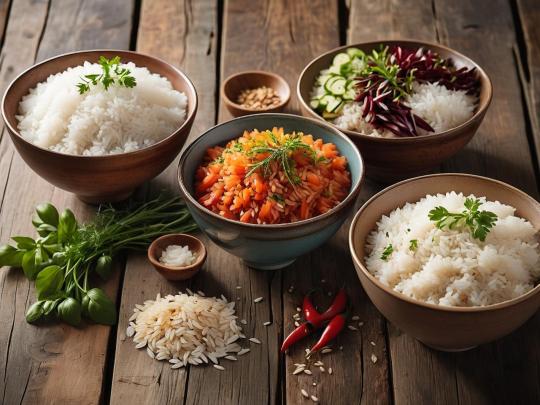
Rice is a staple food for millions of people around the world, providing a versatile and comforting base for countless dishes. With so many varieties available, choosing the healthiest rice for your meals can be overwhelming. Whether you're looking for a quick side dish, a hearty main course, or a gluten-free option, understanding the nutritional benefits and culinary uses of white, brown and red rice can help you make the best choice for your diet and lifestyle.
In this guide you'll explore the unique properties of each rice type, providing valuable information about their health benefits, nutritional profiles and ideal cooking methods. In the end, you'll be armed with the knowledge to choose the right rice for your meals, enhancing both your health and culinary experience.
Nutritional Comparison: White, Brown and Red Rice
When it comes to nutritional content, not all rice is the same. Each variety offers different benefits that meet different dietary needs and preferences.
White rice: Often considered the most popular, white rice is milled and polished, removing the bran and germ. This process results in a softer texture and longer shelf life but also reduces its nutritional content. White rice is typically enriched with iron and B vitamins, making it a robust choice. However, it has a higher glycemic index (GI) than other varieties, which can more significantly impact blood sugar levels.
Brown rice: A whole grain, brown rice retains its bran and germ, preserving essential nutrients such as fiber, magnesium, and phosphorus. Its high fiber content aids digestion and may contribute to heart health by lowering cholesterol levels. Brown rice has a lower GI than white rice, making it a more suitable choice for those managing blood sugar levels.
Red rice: Known for its distinctive color and nutty flavor, red rice is rich in anthocyanins, powerful antioxidants that give it its red color. These antioxidants are believed to reduce inflammation and support heart health. Red rice is also rich in fiber, iron, and other essential nutrients, making it a nutrient-rich option for any meal.
Health Benefits and Considerations
Benefits of white rice: Although often overshadowed by its nutrient-rich counterparts, white rice remains a good choice for those with digestive sensitivities. Its mild flavor and soft texture make it easily digestible, and it is often packed with essential nutrients. Additionally, white rice is a quick-cooking grain, ideal for busy weeknights.
Benefits of brown rice: The fiber in brown rice can aid digestion and promote a feeling of fullness, which can be beneficial for weight management. Its low GI also makes it a better choice for individuals with diabetes or those looking to stabilize blood sugar levels. The nutrient profile of brown rice supports heart health and provides sustained energy.
Benefits of Red Rice: The high antioxidant content in red rice provides unique health benefits, including anti-inflammatory properties and potential protection against chronic diseases. Its robust flavor pairs well with a variety of dishes, making it a versatile addition to your pantry. The iron content in red rice may also be a valuable nutrient for those at risk for anemia.
Choosing the Right Rice for Your Dietary Needs
Choosing the right rice depends on your dietary preferences and health goals. For those following a gluten-free diet, all three types of rice are safe choices. If you are focused on weight management or blood sugar control, brown or red rice may be more suitable due to its low GI and high fiber content. For athletes or individuals who need an instant energy boost, white rice may be a practical option.
Also consider the type of food you're preparing. The neutral flavor of white rice pairs well with a wide range of dishes, from stir-fries to desserts. The chewy texture and nutty taste of brown rice is perfect for grain bowls and salads, while the rich flavor of red rice can enhance soups, stews, and hearty main dishes.
You can also order large quantities of healthy Basmati rice from Vi Exports India.
2 notes
·
View notes
Text
A2 Ghee for Heart Health: How It Works

As we explore the potential of A2 Ghee for heart health, it’s important to recognize its unique nutritional profile and how it interacts with our body’s systems. We’ll uncover the role of Omega-3 fatty acids in managing cholesterol levels and the effects of antioxidants on oxidative stress. Moreover, we can’t overlook the impact of butyric acid on gut health, which can further influence our overall well-being. So, what exactly makes A2 Ghee a valuable addition to our diets? Let’s examine the details that could reshape our understanding of heart-healthy choices.
Understanding A2 Ghee

Understanding A2 ghee opens up a world of nutritional benefits that many might overlook. This unique type of ghee is derived from the milk of cows producing only A2 beta-casein protein, primarily from Desi cows in India. One of the key advantages we find is its digestibility; it’s easier on our stomachs compared to regular ghee, making it suitable even for those who are lactose intolerant.
The traditional production process involves converting milk into curd, churning it to separate butter, and then heating it to purify, resulting in rich, golden-hued ghee. This meticulous method preserves a nutritional profile that’s impressive.
A2 ghee contains essential fat-soluble vitamins A, D, E, and K, along with healthy omega-3 and omega-6 fatty acids. Moreover, it includes butyric acid, which supports gut health and enhances nutrient absorption.
Nutritional Benefits for Heart Health

When we think about heart health, incorporating A2 Ghee into our diet can be a game changer. This rich source of healthy fats, particularly Omega-3 fatty acids, helps lower cholesterol levels and supports overall cardiovascular function. Unlike common misconceptions, A2 Ghee contributes positively to our heart health, thanks to its unique nutritional profile that includes essential vitamins A, D, E, and K.
Here’s a quick overview of A2 Ghee’s nutritional benefits:
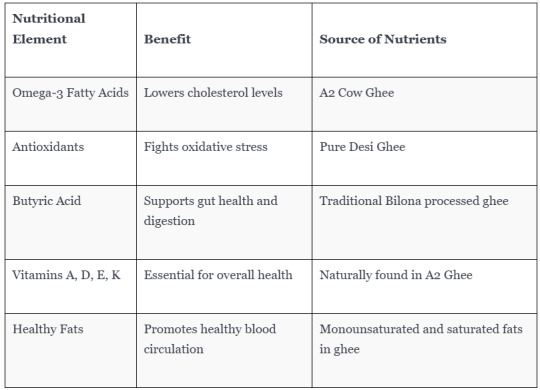
Regularly adding A2 Ghee to our meals could lead to a healthier heart, making it a worthy addition to our balanced diet. Let’s embrace this ancient food for its modern-day benefits!
How A2 Ghee Reduces Inflammation

The antioxidants present in A2 Ghee further enhance its ability to combat inflammation. These compounds neutralize free radicals in our bodies, reducing oxidative stress and preventing damage to our cells. By actively fighting inflammation, A2 Ghee supports our immune system and may lower the risk of chronic diseases linked to inflammation, such as heart disease and arthritis.
Additionally, A2 Ghee is lactose-free, making it a suitable option for those with lactose intolerance while still providing essential nutrients like vitamins A, D, E, and K.
A2 Ghee and Cholesterol Levels

Unlike processed foods high in saturated fats, A2 Ghee supports our cardiovascular health by enhancing HDL production. It transports excess cholesterol to the liver for breakdown, effectively counteracting the negative effects of LDL.
Furthermore, the unique A2 protein in A2 Ghee plays a significant role in this process, helping maintain healthy cholesterol levels. Regularly consuming A2 Ghee can be a simple yet effective way to improve our cholesterol profile.
Its hand-churned, nutrient-rich composition, achieved through the Vedic Bilona process, ensures we get the most health benefits possible. By choosing A2 Ghee, we’re not just enjoying a flavorful ingredient, but we’re also making a conscious effort to support our heart health and overall well-being.
Let’s embrace A2 Ghee as part of our balanced diets!
Incorporating A2 Ghee Into Your Diet

When it comes to cooking, A2 Ghee’s high smoke point makes it perfect for sautéing and frying, adding a rich, nutty flavor to our dishes. Spreading ghee on rotis and parathas is a delicious way to increase nutritional value and promote satiety, reducing unnecessary snacking.
Additionally, drizzling ghee over hot rice or lentils enhances flavor and aids digestion, making meals more satisfying. We can even substitute ghee for butter in our baking, imparting a lighter, buttery flavor to cookies and bread.
Here’s a quick reference table:
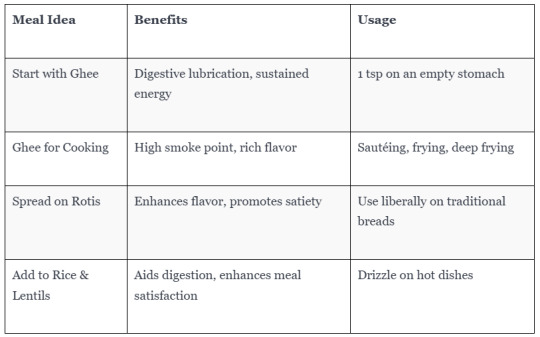
Real Reviews of Raghas A2 Desi Ghee
We’ve gathered some genuine feedback from our customers on Raghas A2 Desi Ghee. People are praising its health benefits, especially for heart health. Many have noticed improvements in their overall well-being and love the rich taste it adds to their meals. The positive experiences shared on platforms like Google My Business highlight the trust and satisfaction that our customers have with our product. Check out these reviews to see why so many choose Raghas A2 Desi Ghee for their cooking needs!

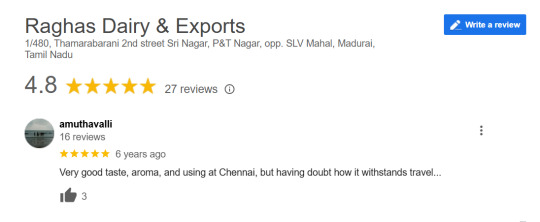
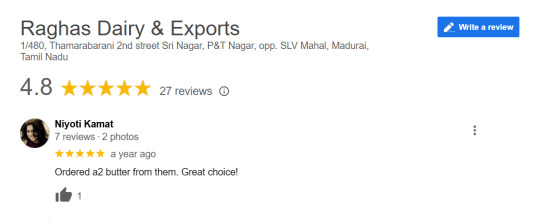
Frequently Asked Questions
How to Consume A2 Ghee?
To consume A2 ghee, we can start by adding one to two teaspoons daily. It enhances dishes, sauté vegetables, or drizzled over meals, making our meals flavorful while providing healthy fats for our diet.
What Are the Side Effects of A2 Ghee?
When we consider A2 ghee, we should be aware of potential side effects like weight gain or digestive discomfort, especially for those with dairy sensitivities. Moderation is key, so let’s enjoy it wisely and mindfully.
Does A2 Ghee Have Omega-3?
Yes, A2 ghee does contain omega-3 fatty acids. By incorporating it into our diet, we can enjoy its heart health benefits, such as better cholesterol levels and reduced inflammation, while savoring its rich flavor.
How to Consume A2 Ghee?
We can consume A2 ghee by using it in cooking, adding it to smoothies, or spreading it on whole-grain bread. Let’s enjoy its rich flavor while benefiting from its nutritious properties in our meals!
Conclusion
In conclusion, A2 Ghee offers us a delicious way to support our heart health. Its rich Omega-3 fatty acids, antioxidants, and butyric acid work together to lower bad cholesterol, reduce inflammation, and improve digestion. By incorporating A2 Ghee into our meals, we not only enhance our culinary experience but also actively promote our cardiovascular wellness. Let’s embrace this nutrient-rich option and enjoy the numerous benefits it brings to our hearts and overall health!
Visit Raghas Dairy to learn more.
#a2 cow ghee#a2 desi ghee#a2 ghee#organic ghee#raghas a2 desi ghee#organic#benefits#ghee#baking#breakfast#hearthealth#vitamins
1 note
·
View note
Text
Not Losing Weight? Inflammation Could Be Your Hidden Enemy!

Inflammation might seem like something that only happens when you’re sick or hurt, but many of us deal with it daily without realizing it. While it’s the body’s natural way of protecting itself during an injury or illness, it can become a problem if it sticks around too long. This ongoing issue can lead to serious health concerns like heart disease, diabetes, and autoimmune disorders. Fortunately, you can take charge of your health by paying attention to what you eat. It’s not just about choosing the right foods; it’s also about making sure they’re fresh and full of nutrients.
Why Does This Happen?
A big part of the problem comes from our modern lifestyles. With processed foods, pollution, and high stress, it’s no surprise our bodies struggle. Fast food, sugary snacks, and processed treats are often easier to grab than fresh fruits and veggies, which can lead to discomfort and weight gain.
Think of this issue like a fire. Once it starts, you can calm it down with better choices. Eating healthier, staying active, getting enough sleep, and managing stress can all help. Your diet is one of the simplest places to begin.
Foods That Trigger Problems
Sugar: Foods loaded with sugar, like cakes and cookies, can raise your blood sugar and cause issues.
Saturated and Trans Fats: These fats, often found in meats, dairy, and baked goods, can linger in your body and trigger problems. Choosing healthier options is a smart move.
Refined Grains: Many breads and snacks are made from refined grains. Opt for whole grains to support your health.
Meat: The fat in certain meats can fuel discomfort.
Grilled Foods: Grilling can taste great, but it can create compounds that lead to problems, especially in fatty meats. Baking, steaming, or broiling can be healthier cooking methods.
Foods That Help Fight Back
There are plenty of delicious foods that can help reduce these issues and support your health. Adding these to your meals can help you feel better naturally.
Fiber: Eating more fiber is a simple way to help your body combat problems. Foods like whole grains, beans, and leafy greens are packed with fiber, which helps keep your blood sugar steady and supports healthy digestion. They also lower the risk of diseases like diabetes and heart issues.
Plant-Based Proteins: Nuts, seeds, beans, and lentils are great meat alternatives filled with nutrients that can help fight back. If you enjoy soy, choose natural options like tofu or edamame instead of highly processed products.
Colorful Fruits and Veggies: More color on your plate means more nutrients. Bright fruits and vegetables like berries, tomatoes, spinach, and broccoli are full of antioxidants that help your body. Aim for a variety of colors to get a mix of different nutrients.
Herbs and Spices: Using herbs and spices not only adds flavor but can also help reduce problems. Turmeric, ginger, cinnamon, and basil have natural properties that are beneficial, making them a great way to boost your meals without extra salt or sugar.
Omega-3s: These healthy fats, found in foods like salmon, flax seeds, and walnuts, are known for their ability to help. Try to include a source of omega-3s in your diet each day to support heart health.
Small Changes for Healthy Living
You don’t have to overhaul your entire diet overnight. Instead, focus on small, steady changes that add up over time. Start by adding more fiber, colorful veggies, and omega-3s to your meals while cutting back on sugary snacks and processed fats. These simple adjustments can also boost your energy levels.
What you put on your plate has a big impact on how you feel. Thoughtful choices about your food help keep your body healthy and thriving. Choose nourishing ingredients that fuel your energy and support your well-being. Adding whole, fresh foods to your meals not only improves your physical health but also builds a positive relationship with what you eat.
#healthy food#healthychoices#healthylifestyle#healthy diet#food#healthy eating#fitness#healthyhabits#stomach ache#inflammation#weight loss#diet#fat loss#weight management#trending#naturalgoodness
1 note
·
View note
Text
Top 10 Reasons to Choose Avitus Foods as Your Cold Pressed Groundnut Oil Supplier
Introduction
If you're on the hunt for a reliable cold pressed groundnut oil supplier, look no further than Avitus Foods. With a growing awareness of the health benefits associated with cold pressed oils, more people are making the switch. But with so many brands on the market, why choose Avitus Foods? Here, we break down the top 10 reasons that set Avitus Foods apart from the competition.
The Popularity of Cold Pressed Groundnut Oil
Cold pressed groundnut oil is not just a trend; it's a lifestyle choice for many health-conscious individuals. This oil retains more nutrients and has a richer flavor compared to its conventionally processed counterparts. It's an excellent choice for cooking, frying, and even salad dressings, making it a versatile kitchen staple.

Why Choose Avitus Foods?
So, why should Avitus Foods be your go-to supplier for cold pressed groundnut oil? Let's dive into the top reasons.
Reason 1: High-Quality Standards
At Avitus Foods, quality is non-negotiable. They adhere to stringent quality control processes to ensure that every bottle of oil meets the highest standards. From sourcing the best groundnuts to the final packaging, every step is meticulously monitored.
Reason 2: Pure and Natural Ingredients
Avitus Foods prides itself on using only the purest and most natural ingredients. Their cold pressed groundnut oil is free from additives, preservatives, and chemicals, making it a healthy choice for you and your family.
Reason 3: Rich Nutritional Profile
Cold pressed groundnut oil from Avitus Foods is packed with essential nutrients. It’s rich in vitamins, antioxidants, and healthy fats that support heart health, reduce inflammation, and promote overall well-being.
Reason 4: Sustainable and Ethical Sourcing
Sustainability is at the heart of Avitus Foods’ operations. They ensure that their groundnuts are sourced ethically, supporting local farmers and sustainable farming practices. This commitment to the environment and the community is a significant reason to choose Avitus Foods.
Reason 5: Advanced Cold Pressing Techniques
Avitus Foods employs advanced cold pressing techniques that preserve the nutritional integrity of the oil. Unlike conventional methods that use heat and chemicals, cold pressing ensures that the oil retains its natural flavor and health benefits.
Reason 6: Excellent Customer Service
Customer satisfaction is a top priority for Avitus Foods. Their customer service team is responsive, knowledgeable, and always ready to assist with any queries or concerns, ensuring a smooth and pleasant buying experience.
Reason 7: Competitive Pricing
High-quality doesn’t have to mean high prices. Avitus Foods offers competitive pricing, making premium cold pressed groundnut oil accessible to a broader audience without compromising on quality.
Reason 8: Positive Customer Reviews
Don’t just take our word for it – the positive feedback from satisfied customers speaks volumes. Many users praise Avitus Foods for the quality and flavor of their oil, as well as the company's reliable service.
Reason 9: Versatile Usage
Whether you're cooking up a storm in the kitchen, making a salad, or even baking, Avitus Foods' cold pressed groundnut oil is incredibly versatile. Its high smoke point and rich, nutty flavor make it a perfect addition to a variety of dishes.
Reason 10: Strong Brand Reputation
Avitus Foods has built a solid reputation in the market for their dedication to quality and customer satisfaction. When you choose Avitus Foods, you’re opting for a brand that stands by its promises and delivers excellence.
Conclusion
In conclusion, Avitus Foods is a top contender when it comes to choosing a cold pressed groundnut oil supplier. Their commitment to quality, sustainability, and customer satisfaction makes them a standout choice. Whether you’re new to cold pressed oils or a seasoned user, Avitus Foods offers a product that you can trust and enjoy.
FAQs
Q1: What makes cold pressed groundnut oil healthier than regular groundnut oil?
Cold pressed groundnut oil retains more nutrients and antioxidants because it’s extracted without heat or chemicals, preserving its natural goodness.
Q2: How should I store cold pressed groundnut oil?
Store it in a cool, dark place away from direct sunlight to maintain its freshness and nutritional value.
Q3: Can I use cold pressed groundnut oil for frying?
Yes, it has a high smoke point, making it suitable for frying, sautéing, and other high-heat cooking methods.
Q4: Is Avitus Foods' groundnut oil suitable for vegans?
Absolutely! It’s 100% plant-based and free from any animal products or by-products.
2 notes
·
View notes
Text
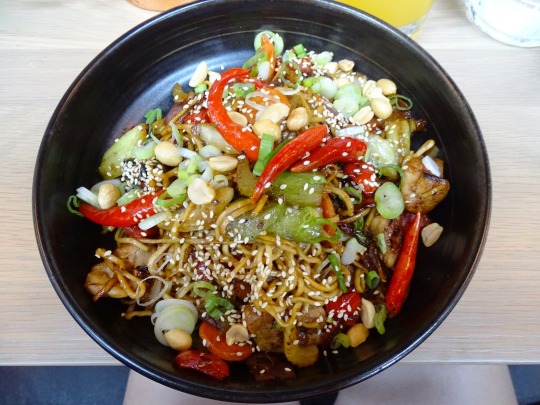









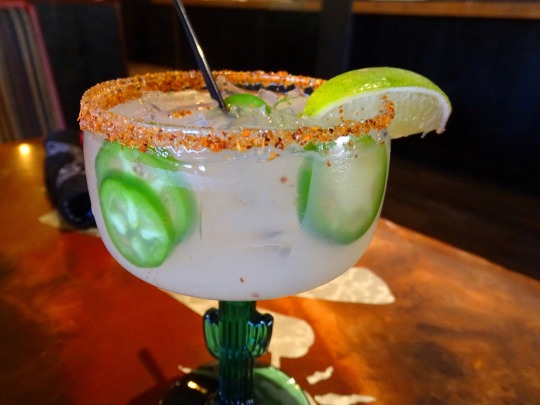
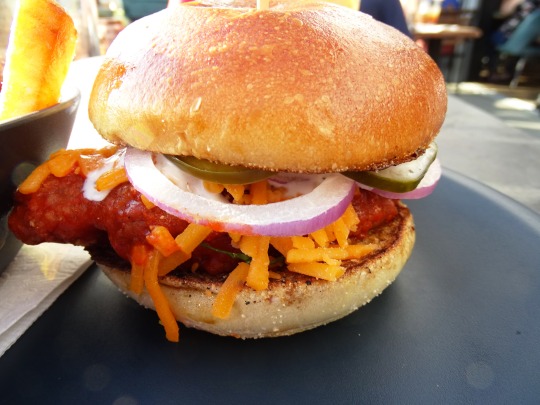















National Hot Heads Chili Day
Chili lovers celebrate National Hot Heads Chili Day on January 17 every year. On this day, chili heads, heat-seekers, and extreme eaters try out the spiciest chilis. National Hot Heads Chili Day is celebrated with habanero-eating challenges, fancy-dress contests, and cook-offs of popular recipes. Chilis are also made to take the official Scoville heat scale. This doesn’t mean that you have to be a daredevil to celebrate the day — anyone who likes their meal a little hot can celebrate the day! Spices and chilis add a distinct flavor to the dish. Thai, Indian, Creole and Caribbean dishes are famous for their heat content and boast of some excellent gastronomic experiences!
History of National Hot Heads Chili Day
We don’t quite know how National Hot Heads Chili Day came to be but it’s safe to say that one fine day all the chili lovers got together and decided to celebrate hot and spicy food. This makes sense given how humans have always had a knack for chilis in their food — the first recipes for spicy foods go back to 6,000 years! This means that humans have been enjoying spicy food for quite some time. While the foods that we enjoy today may have changed and recipes altered, we still love spicy food. Unlike other animals, humans prefer spicy food simply because it tastes so incredible and on a plus side, spices also offer several health benefits.
Spices such as turmeric and cumin that have powerful antimicrobial and antioxidant properties can kill bacteria outright. Studies show that the capsaicin in hot peppers can reduce inflammation and decrease the chances of heart disease. It can also aid in weight loss. In Ayurvedic medicine, the inflammatory properties of chilis have brought relief from many different conditions, such as headaches, autoimmune disorders, and arthritis. Spicy foods can also help fasten your metabolism. Studies also show that certain spices, like pepper chilies, turmeric, cinnamon, and cumin can curb your appetite and improve your metabolic resting rate. Who knew chilis could be so versatile!
National Hot Heads Chili Day timeline
3500 B.C.
Chilis Are Cultivated
Chilis are grown and cultivated for the first time.
1498
Chilis Arrive In India
Vasco-da-Gama reaches Indian shores and introduces India to chilis.
1912
Scoville Organoleptic Test
Wilbur L. Scoville finds a new method to measure the pungency of chilis.
1975
Chili’s
Larry Lavine opens the first Chili's in Dallas.
National Hot Heads Chili Day FAQs
Are chillies native to India?
After the Portuguese arrival in India, chilies were first introduced to Goa, from where they spread to South India. Today, India is the largest producer of red dried chili in the world.
Which chili is the spiciest?
A Guinness Book record holder, Bhut Jolokia is certified as the hottest chili in the world. It is also known as ‘ghost pepper’ and is cultivated in Arunachal Pradesh, Assam, Nagaland, and Manipur.
Which chili is the healthiest?
Green chilies have high water content and zero calories which makes them a healthy choice for those who are trying to shed some pounds.
National Hot Heads Chili Day Activities
Host a dinner party: Chilis are regularly used in Indian, Chinese, and Thai cooking. Host a dinner party and serve these cuisines to friends and family.
Learn about different chilis from around the world: On National Hot Heads Chili Day, learn more about the different chilies that are available around the world. There are so many different types, including Carolina Reapers, Ghost Peppers, Habanero, Red Cayenne Pepper, Serrano, Guajillo, Poblano, Peppadew, and much more.
Organize a cook-off: Invite your friends over and see who can create the best hot and spicy dish. Flavor your dishes with different types of chilis and find out which one is the hottest.
5 Facts About Chilis That Will Blow Your Mind
Chilis can make you happy: They help release feel-good endorphins and dopamine, which results in a sense of euphoria.
The Japanese had an innovative use: Instead of eating them, the Japanese put them in their socks to keep their toes warm.
They are rich in nutrients: They contain large amounts of vitamin C, provitamin A, and beta-carotene.
Only mammals are sensitive to chilis: Capsaicin may burn and irritate the flesh of mammals but birds are completely immune to its effects
They can be used as first aid: Cayenne pepper can help stop bleeding.
Why We Love National Hot Heads Chili Day
A day to enjoy your favorite foods: Most of us love spicy foods but it’s not possible to savor them every day. National Hot Heads Chili Day offers the perfect opportunity to indulge in your favorite spicy food.
Try a new cuisine: If you don't have an adventurous palate, today is the best day to rectify that. Sample spicy foods from India, Thailand, the Philippines, and the Caribbean.
A day to be adventurous: If you are an adventurous foodie, then National Hot Heads Chili Day invites you to taste some of the hottest and steamiest chilies from the world over. Go on a gastronomic adventure today!
Source
#Green Chile Cheeseburger#Chili Cheese Fries#Chili Burger#Green Chili Stew#Chicken Hunan Kung Pao#Eric's Burger#Passionfruit Chili Margarita#National Hot Heads Chili Day#travel#original photography#vacation#USA#Canada#Sweden#restaurant#street food#NationalHotHeadsChiliDay#17 January
5 notes
·
View notes
Text
Health Importance of Black Rice
Introduction
Black rice is also known as forbidden rice or purple rice, primarily cultivated in the northeastern states of India, with Manipur being a significant producer. its is a G.I Tag Crop of Manipur and here it is known as “Chak-Hao”, this rice that has gained attention in recent years due to its unique color, distinct flavor, and impressive nutritional profile. Historically, it was once considered a rare and precious grain reserved for royalty in ancient China. The nutritional value of black rice (100 g, cooked rice)
· Calories: 150 kcal · Carbohydrates: 34 g · Protein: 3 g · Fat: 1.5 g · Fiber: 2 g · Vitamin E: 0.8 mg · Iron: 1.5 mg · Magnesium: 43 mg · Phosphorus: 101 mg · Potassium: 84 mg · Zinc: 1.2 mg Black rice is also a good source of various vitamins and minerals, as well as dietary fiber & a powerful antioxidant, Anthocyanin. These values are approximate & can vary slightly depending on factors such as the variety, growing conditions, and processing methods. Health Benefits of Black Rice:
1. Rich in Antioxidants, as anthocyanins, reducing oxidative stress and inflammation 2. Improved Heart Health by reducing cholesterol levels, improving blood vessel function, and regulating blood pressure. 3. Improved Digestion by its high fiber content which aids in digestion and can help prevent constipation. 4. Blood Sugar Regulation, due to the slow digestibility of black rice, beneficial in diabetes. 5. Cancer Prevention, anthocyanins have potential anti-cancer properties and may help inhibit the growth of cancer cells 6. Weight Management due to high fiber & slow digestion 7. Nutrient rich food, maintain overall health & improve immune system 8. Allergen-Free, free from gluten sensitivity or celiac disease. 9. Neuroprotective effect improve Brain Health
Black rice has a slightly nutty flavour & chewy texture. It requires longer cooking time and more water than white rice due to its bran layer. It can be used in both sweet and savoury dishes. In Asian cuisines, black rice is often used in traditional desserts, rice-based puddings, and porridge. It can also be incorporated into salads, side dishes, and even main courses for a visually striking and nutrient-rich meal
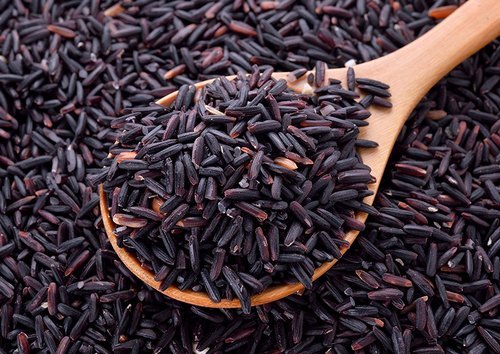
2 notes
·
View notes
Text
The Health Benefits of Ghee from A2 Milk: Why Giramritphal Stands Out
In recent years, there has been a growing interest in traditional foods that offer both nutritional value and health benefits. One such superfood is ghee made from A2 milk, which has gained popularity due to its rich flavor and numerous health advantages. Brands like Giramritphal have taken the lead in providing high-quality A2 ghee, ensuring purity and authenticity. But what makes ghee from A2 milk so special, and why should you consider adding it to your diet?
What is A2 Milk Ghee?
Ghee, a form of clarified butter, has been a staple in Indian households for centuries. However, not all ghee is created equal. Ghee made from A2 milk comes from cows that produce milk containing only the A2 beta-casein protein, as opposed to the more common A1 protein found in regular milk. This distinction makes A2 ghee easier to digest and less likely to cause inflammation or digestive discomfort.
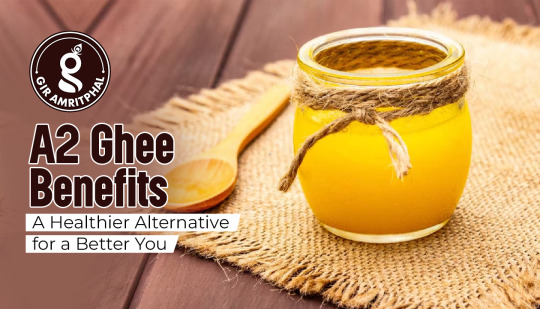
Health Benefits of A2 Milk Ghee
Rich in Nutrients – A2 ghee is packed with essential fatty acids, vitamins A, D, E, and K, and antioxidants that support overall health.
Boosts Digestion – Unlike regular ghee, A2 ghee is gentle on the stomach and helps improve gut health by promoting good bacteria.
Supports Heart Health – Contrary to the myth that ghee is unhealthy, A2 ghee contains healthy fats that can help maintain cholesterol levels when consumed in moderation.
Enhances Immunity – The butyric acid in A2 ghee strengthens the immune system and reduces inflammation.
Promotes Brain Function – The healthy fats in ghee support cognitive health and may help improve memory and focus.
Why Choose Giramritphal A2 Ghee?
When it comes to purchasing ghee from A2 milk, quality matters. Giramritphal is a trusted brand known for its pure, chemical-free, and traditionally prepared A2 ghee. Their ghee is made using the bilona (churning) method, ensuring that all the natural nutrients are preserved.
Key Features of Giramritphal A2 Ghee:
Made from 100% desi cow’s milk
No additives or preservatives
Rich, aromatic, and full of natural goodness
Supports sustainable and ethical farming practices
How to Use A2 Ghee in Your Diet
You can incorporate A2 ghee into your daily meals in various ways:
Use it for cooking instead of refined oils
Add a spoonful to dal, rice, or roti for enhanced flavor
Use it in Ayurvedic remedies like herbal concoctions
Apply it on chapatis or drizzle over warm khichdi
Final Thoughts
Ghee from A2 milk is more than just a cooking fat—it’s a powerhouse of nutrition with deep roots in Ayurveda. Brands Like Giramritphal, ensure that you get the purest form of A2 ghee, made with care and tradition. Whether you're looking to improve digestion, boost immunity, or simply enjoy a richer taste in your food, switching to A2 ghee can be a game-changer for your health.
0 notes
Text
The Ultimate Guide to Salt and Vinegar Pork Rinds
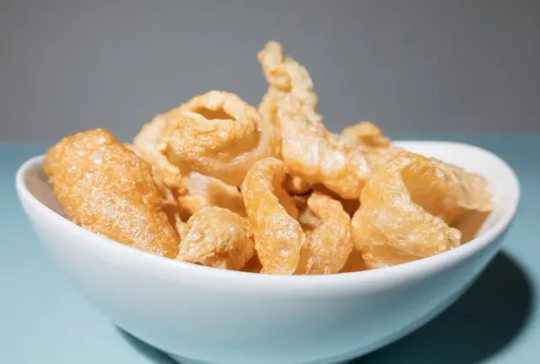
There’s something undeniably crave-worthy about the bold zing of salt and vinegar, especially when paired with the irresistible crunch of pork rinds. Whether you’re following a low-carb lifestyle, exploring savory snacks beyond chips, or just craving something uniquely satisfying, salt and vinegar pork rinds deliver a full-flavor experience with zero guilt. But what exactly makes them so addictive? How do they fit into a healthy diet? Are they just for keto folks, or can anyone enjoy them? This guide takes you deep into everything—from nutrition to cooking ideas to flavor science—so you can crunch smarter and snack better.
Key Takeaways
Salt and vinegar pork rinds are naturally low-carb, high-protein, and gluten-free.
Their bold flavor comes from vinegar powder, salt, and other umami-rich seasonings.
They're a great option for keto, paleo, and other clean eating lifestyles.
Pork rinds are more than a snack—they can be used in cooking, baking, and even as a breading substitute.
Not all pork rinds are created equal; ingredient quality and preparation methods matter.
1. What Are Pork Rinds, Really?
Pork rinds might seem like a trendy snack today, but they’ve actually been around for centuries, deeply rooted in food cultures across the globe. At their core, pork rinds are made from one simple ingredient: the skin of a pig. But the transformation from skin to crunchy snack is where the magic happens.
To make pork rinds, the skin is first cleaned and simmered to remove excess fat. After that, it's dried out—sometimes for hours, even days—to get rid of moisture. The final step is frying or baking at high heat, which causes the skin to puff up dramatically, forming the airy, crispy texture we recognize. The result? A light yet rich snack that delivers a satisfying crunch.
Unlike other snacks that rely on grains, flour, or artificial fillers, pork rinds are naturally carb-free and gluten-free. They offer a surprisingly high amount of protein and fat, making them popular with low-carb and high-protein diets like keto or paleo. While they might once have been labeled as “junk food,” their simplicity and evolving quality have helped them earn a fresh reputation—as both a nostalgic treat and a modern, health-conscious option for people who want real flavor with fewer ingredients.
2. Why Salt and Vinegar? The Flavor Combo Explained
Salt and vinegar is a classic flavor combo for a reason. The salt amplifies savory notes, while the vinegar adds a bright, acidic kick that wakes up your taste buds. When paired with the rich, fatty base of pork rinds, the result is a balance that hits every craving.
So where does the bold flavor come from?
Vinegar powder (often derived from white or apple cider vinegar) delivers the tang without making the snack soggy.
Salt enhances the natural umami of pork.
Citric and malic acids deepen the sour notes.
Natural spices like garlic, onion, and pepper round out the profile.
It’s a surprisingly refined formula for a snack that still feels indulgent.
3. Nutrition Breakdown: Guilt-Free Crunch?
Salt and vinegar pork rinds might be one of the rare snacks that actually deliver on flavor and nutrition—at least when compared to traditional options like chips or crackers. A standard 1-ounce (28g) serving typically contains 150 to 180 calories, 17 to 20 grams of protein, 9 to 11 grams of fat, and zero carbs. That’s a powerful nutritional profile, especially for those following low-carb, keto, or high-protein diets.
The protein content alone makes pork rinds stand out—more than what you’d find in a boiled egg or most protein bars of similar calorie count. Plus, the absence of carbohydrates and gluten makes them a go-to snack for people managing blood sugar, reducing inflammation, or avoiding grains.
However, the key is ingredient quality. Some brands use additives like sugar, monosodium glutamate (MSG), or inflammatory oils (such as soybean or canola oil), which can counteract the benefits. Others keep it simple with pork skin, salt, vinegar powder, and clean seasonings.
So, while the macros might scream “guilt-free,” always read the label. Look for short, recognizable ingredient lists and skip the versions with unnecessary fillers. Done right, pork rinds are not just crunchy—they’re a snack you can feel good about.
4. Are They Actually Healthy? Let’s Talk Context

The word healthy can mean different things depending on your goals.
For low-carb dieters: They’re ideal.
For high-protein needs: They deliver.
For gluten or grain-free lifestyles: Perfect fit.
For low-sodium diets: Maybe not.
While they’re not a superfood, they’re certainly a better choice than chips or pretzels loaded with refined carbs, artificial additives, and seed oils. And when eaten mindfully, they can be part of a balanced lifestyle—especially if paired with veggies, dips, or lean protein.
5. How They Fit into Keto and Low-Carb Diets
Pork rinds were practically made for keto.
Zero carbs = keto gold
High fat and protein = great for energy and satiety
No grains or sugar = ketosis stays intact
Even better? The salt can help with electrolyte balance, especially during the first few weeks of keto when sodium levels drop.
Salt and vinegar pork rinds add flavor variety to what can sometimes feel like a repetitive eating pattern. They’re quick, portable, and keep you on track—without sacrificing taste.
6. Everyday Uses: Beyond Just Snacking
You don’t have to eat pork rinds straight from the bag (though we wouldn’t blame you if you did). Here are some creative ways to incorporate them:
a. Breading Substitute
Use crushed pork rinds as a low-carb breadcrumb alternative. Great for chicken tenders, fish fillets, or even cauliflower bites.
b. Casserole Topping
Add a salty, crunchy topping to baked dishes—mac and cheese, keto lasagna, or eggplant parmesan.
c. Dip Companion
They pair beautifully with guacamole, sour cream-based dips, or buffalo chicken spread.
d. Salad Crunch
Toss a few broken pieces into your salad for a crouton alternative that’s full of flavor.
For more recipe ideas and usage hacks, see The Ultimate Guide to Salt and Vinegar Pork Rinds.
7. Homemade vs. Store-Bought
You can make pork rinds at home, though it takes time and patience. Homemade versions let you control the quality of fat used and customize your seasoning. But let’s be real—most of us prefer the convenience of pre-made options.
When buying from a store or online, here’s what to look for:
Short ingredient lists
No added sugars or fillers
Natural flavorings over artificial ones
Lard-cooked vs. seed oil-cooked (if you're picky about fats)
8. Flavor Variations & Trends
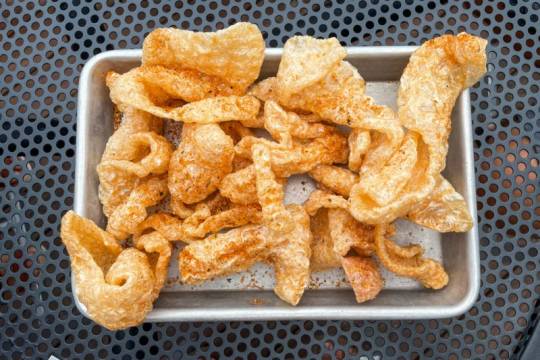
Salt and vinegar may be the bold standout, but it’s just one chapter in the growing story of pork rind flavors. As more people look for high-protein, low-carb snacks that actually taste good, brands have responded with a range of creative variations. You’ll now find pork rinds in flavors like spicy chili lime, smoky barbecue, jalapeño cheddar, garlic parmesan, and even sweet heat—blending heat with subtle sweetness for a unique twist.
These flavor innovations aren’t just about novelty. They cater to a broader audience, including foodies, wellness enthusiasts, and even home chefs looking to elevate everyday recipes. Some versions use clean-label seasonings with organic spices or natural fermentation-based acids for a more refined taste. Others push the envelope with global influences like Korean gochujang, Indian curry, or Mexican street corn-style seasoning.
Trends also show a shift toward better-for-you ingredients, with many consumers seeking pork rinds cooked in lard or avocado oil instead of processed seed oils. There’s also growing demand for pasture-raised pork sources and paleo-friendly certifications.
As flavor profiles evolve and the snack aisle expands, pork rinds are shedding their gas station stigma and becoming a bold, diverse, and surprisingly gourmet option for mindful eaters.
9. Who’s Eating Them? (Hint: Not Just “Keto Bros”)
Sure, they’re big in the keto community, but pork rinds have a surprisingly wide appeal:
Busy parents looking for lunchbox snacks
Athletes who need quick protein hits
Office workers seeking a mid-day crunch without sugar crashes
Older generations who grew up with them and are rediscovering their benefits
Their clean label and convenience make them accessible—even if you’re not following any particular diet.
Conclusion: A Snack That Actually Earns Its Crunch
In a world full of flashy snacks with long ingredient lists and questionable health claims, salt and vinegar pork rinds stand out for what they don’t include—no grains, no sugar, no filler. Just real ingredients delivering big flavor and satisfying crunch. Whether you’re reaching for them as a quick protein boost, a carb-free snack, or even a creative cooking ingredient, they offer a rare combination: convenience, taste, and nutritional value.
The bold tang of vinegar balanced with rich, crispy pork skin is more than just a flavor—it’s an experience. And for those following keto, low-carb, or gluten-free lifestyles, it’s a welcome change from the usual snack lineup. But even if you’re not following a strict diet, these rinds deliver something that’s hard to find: guilt-free snacking that doesn’t feel like a compromise.
As long as you keep an eye on ingredients and practice mindful snacking, pork rinds can absolutely have a place in your pantry. They’re not just old-school—they’re evolving. And as trends move toward cleaner labels and higher standards, it’s safe to say this humble snack has earned its spot at the top of the crunch food chain.
Frequently Asked Questions (FAQs)
1. Are salt and vinegar pork rinds keto-approved?
Yes, they’re perfect for keto due to their zero-carb profile and high fat content. Just watch for added sugars or artificial ingredients.
2. Can I eat pork rinds daily?
In moderation, yes. They’re a better snack than many processed options, but it’s best to balance them with whole foods.
3. Do salt and vinegar pork rinds have MSG?
Some do, some don’t. Always read the label if you're sensitive to MSG or trying to avoid additives.
4. Are they gluten-free?
Yes, pork rinds are naturally gluten-free and grain-free, making them a great option for those with celiac or gluten sensitivities.
5. Do pork rinds go bad?
Like any packaged food, they have a shelf life. Store them in a cool, dry place and keep the bag sealed to maintain crispness.
0 notes
Text
Olive Oil vs Avocado Oil: A 500-Word Comparison
When it comes to healthy cooking oils, two contenders often stand out—olive oil vs avocado oil. Both oils are praised for their nutritional benefits, culinary versatility, and heart-healthy fats. But which one truly reigns supreme in your kitchen? Let’s dive into the similarities and differences between these two oils to help you make an informed choice.
Origin and Production
Olive oil is made by pressing olives, the fruit of the olive tree, a staple in Mediterranean regions for thousands of years. Avocado oil, on the other hand, is extracted from the pulp of the avocado fruit, native to Central and South America. Both oils are made using cold-pressing methods for their extra virgin varieties, preserving their nutrients and flavor.
Nutritional Profile
When comparing olive oil vs avocado oil, both are rich in monounsaturated fats, the heart-healthy type that helps reduce bad cholesterol levels. Olive oil contains slightly more polyphenols—powerful antioxidants that support overall health. However, avocado oil boasts a slightly higher vitamin E content, which is essential for skin health and immune function.
Per tablespoon, both oils offer about 120 calories and 14 grams of fat. But the exact nutrient profile can vary depending on whether the oil is refined or unrefined.
Smoke Point and Cooking Use
One of the key factors in the olive oil vs avocado oil debate is smoke point. Avocado oil has a higher smoke point—up to 520°F (271°C)—making it ideal for high-heat cooking like frying, grilling, and roasting. In contrast, extra virgin olive oil has a smoke point around 375°F (190°C), suitable for sautéing, drizzling, and medium-heat cooking.
For raw uses like salad dressings, dips, or finishing touches, both oils shine. Olive oil’s bold, fruity flavor adds depth to Mediterranean dishes, while avocado oil has a more neutral taste, making it a versatile choice for a wider range of cuisines.
Health Benefits
In the health category of olive oil vs avocado oil, both oils support heart health, reduce inflammation, and promote nutrient absorption. Olive oil has been extensively studied for its role in the Mediterranean diet, linked to reduced risk of cardiovascular disease, stroke, and even some cancers. Avocado oil, while newer to the scene, has shown promise in supporting joint health and reducing blood pressure.
Cost and Availability
Olive oil is widely available and tends to be more affordable, especially in regions where it is produced. Avocado oil, being less common, is generally more expensive. However, the price difference has narrowed in recent years as avocado oil grows in popularity.
Conclusion
So, when it comes to olive oil vs avocado oil, there is no clear winner. Each has its strengths. Choose olive oil for its rich flavor, proven health benefits, and affordability. Opt for avocado oil when you need a high smoke point or a neutral taste. Better yet, keep both in your kitchen and use them based on your cooking needs. Whether you’re sautéing vegetables or dressing a salad, both oils are excellent choices for a healthy lifestyle.
0 notes
Text
Discover the True Essence of Premium Sri Lankan Cinnamon
Sri Lanka has been known for its aromatic spices since ancient times, and among these, cinnamon holds a place of pride. This spice is not only a flavouring agent but also a cultural treasure of the island. The traditional cultivation and harvesting methods have been passed down for generations, making Sri Lankan cinnamon one of the most sought-after spices in global markets today. Whether used in cooking, baking, or herbal wellness preparations, cinnamon continues to enhance lifestyles across the world.

Why Sri Lankan Cinnamon Stands Out Globally
Midway through understanding its uniqueness, it is important to note that sri lankan cinnamon is often called “true cinnamon” due to its purity and mild sweetness. Its delicate layers are thin, smooth, and easily ground into powder without leaving a rough texture. This characteristic differentiates it from cassia, which is thicker and harder. Sri Lankan cinnamon’s subtle aroma with citrusy and floral undertones makes it ideal for culinary applications, where flavour refinement is essential.
Exploring Alba Ceylon Cinnamon’s Exceptional Grade
When speaking of quality grades within Sri Lankan cinnamon, alba ceylon cinnamon is the highest and finest. Alba cinnamon sticks are slender, with an exquisite golden-brown hue, harvested meticulously to maintain their delicate structure. This grade is preferred by luxury culinary experts because it carries the most refined sweetness and lightness in aroma. Its taste is mild yet impactful, enhancing dishes without overpowering them, making it the pinnacle of cinnamon quality that chefs and premium wellness brands choose confidently.
Health Benefits of Including Alba Cinnamon in Diet
In addition to culinary charm, this cinnamon grade offers numerous health benefits. Its antioxidant properties support cellular health and reduce inflammation, which is vital for overall well-being. Regular use of Alba cinnamon can help regulate blood sugar levels, contributing positively to metabolic health and diabetes management. Its antibacterial nature also makes it a natural preservative in food preparations while supporting oral hygiene when used in mouth rinses or infused teas.
How Sri Lankan Cinnamon Enhances Daily Recipes
Incorporating Sri Lankan cinnamon into daily recipes elevates flavour and aroma effortlessly. For morning oats, adding ground cinnamon not only enriches taste but also improves digestion. Desserts like rice pudding, cinnamon rolls, or fruit tarts become more authentic with Ceylon cinnamon’s subtlety. Even savoury dishes, such as curries and biryanis, achieve deeper flavour notes when infused with small pieces of cinnamon sticks during the cooking process, enhancing both nutrition and aroma.
The Cultural Importance of Cinnamon in Sri Lanka
For centuries, cinnamon has shaped the country’s culture, economy, and global trade recognition. Harvesting this spice involves skilled peeling and rolling, which is an art passed through generations of Sri Lankan families. Cinnamon estates remain symbols of tradition and dignity in rural regions, where entire communities depend on this fragrant crop for their livelihood. Its export continues to boost Sri Lanka’s global economic footprint, ensuring the spice retains its title as the world’s best cinnamon.
Final Thoughts on Choosing Authentic Sri Lankan Cinnamon
Choosing authentic Sri Lankan cinnamon ensures not only premium taste but also ethical sourcing and traditional cultivation that honours nature and communities. Alba Ceylon cinnamon, being its purest form, stands as the gold standard for health-conscious consumers and culinary artists worldwide. Integrating this spice into your diet can transform your wellness and culinary experiences with its unmatched subtlety and warmth.
0 notes
Text
7 Digestive Benefits of Organic A2 Ghee

As we explore the realm of digestive well-being, the benefits of organic A2 ghee unfold with intriguing clarity. The impact on our digestive system goes beyond mere sustenance; it delves into a realm of enhanced nutrient absorption and a nurturing environment for gut health. These seven benefits, anchored in science and tradition, offer a glimpse into a world where ancient wisdom meets modern wellness practices. Let’s uncover the secrets that organic A2 ghee holds for our digestive health.
Easier Digestion
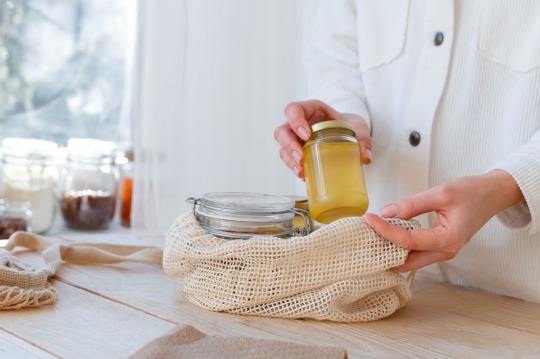
When considering the easier digestion of ghee compared to butter, it’s crucial to understand the key factors that contribute to this digestive advantage.
Ghee, being essentially butter with its water and milk solids removed, presents a concentrated form of fat that’s gentler on the stomach. This absence of milk solids in ghee plays a significant role in its digestibility, making it a favorable option for individuals with sensitive digestive systems.
Moreover, ghee is almost lactose-free, unlike butter, which contains small amounts of lactose that can lead to digestive discomfort in lactose intolerant individuals. By removing these elements, ghee becomes a more easily digestible option for those with lactose intolerance.
However, it’s essential to note that trace amounts of milk solids may still be present in some ghee brands, posing a potential issue for individuals with severe milk allergies.
Reduced Discomfort

Regularly incorporating organic A2 Ghee into our diet can lead to reduced discomfort, especially in joint pain management. The pure form of ghee, like Milkio grass-fed ghee, contains medicinal properties that aid in alleviating joint pain.
Ghee acts as a natural hydrator, keeping body tissues soft and supple, ultimately reducing discomfort in joints. Furthermore, the presence of vitamins A, D, E, and K2 in ghee supports bone health, aiding in maintaining joint flexibility and strength.
The traditional method of making ghee, as seen in Milkio ghee, ensures the preservation of essential nutrients without any artificial additives, contributing to its effectiveness in providing relief from discomfort.
Enhanced Nutrient Absorption

Enhancing nutrient absorption, organic A2 Ghee serves as a valuable addition to one’s diet due to its ability to improve the intake of fat-soluble vitamins and minerals. When consumed with ghee, vitamins A, D, E, and K are better absorbed as they require the presence of fat for optimal assimilation. This enhanced absorption ensures that the body can make the most of these essential nutrients, contributing to overall well-being.
By incorporating organic A2 Ghee into meals, individuals can boost their nutritional intake and support better health outcomes.
Furthermore, it’s crucial to note that high-heat cooking methods can degrade the beneficial compounds present in ghee. To preserve the nutrients like butyrate and CLA, it’s recommended to add ghee after cooking. This ensures that the full benefits of these compounds, which support gut health, have anti-inflammatory properties, and aid in metabolism and immune function, are retained for maximum health advantages.
Healthy Gut Environment
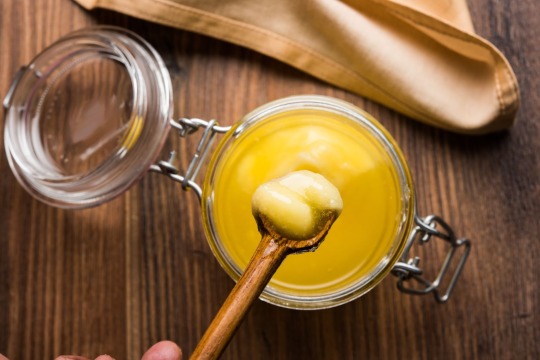
Ghee contributes to nurturing a healthy gut environment by supporting the growth of beneficial bacteria and reducing inflammation in the digestive system. The butyric acid present in ghee plays a crucial role in promoting gut lining health, potentially decreasing gut inflammation, and nourishing beneficial gut bacteria. By incorporating organic A2 ghee into your diet, you can create a more favorable environment in your gut that supports overall digestive wellness.
Maintaining a healthy gut is essential for proper digestion and overall well-being. Ghee’s ability to reduce inflammation can help alleviate digestive discomfort and create a more harmonious environment for the gut microbiome to thrive.
Additionally, the anti-inflammatory properties of ghee can contribute to a healthier gut lining, which is vital for optimal nutrient absorption and digestive function. Prioritizing a healthy gut environment through the consumption of organic A2 ghee can have significant benefits for your digestive health.
Smoother Digestion

Consuming organic A2 ghee can lead to smoother digestion, promoting gut health and overall well-being. The unique composition of A2 ghee aids in easier digestion compared to other dairy products.
Its lactose-free nature makes it suitable for individuals intolerant to lactose, reducing the likelihood of digestive discomfort. A2 ghee also supports the growth of beneficial gut bacteria, contributing to a balanced gut microbiome essential for optimal digestion.
The natural lubrication provided by ghee helps in easing the passage of food through the digestive tract, reducing the chances of bloating or indigestion. Starting the day with a tablespoon of A2 ghee can provide the necessary healthy fats for lubrication, supporting digestive processes throughout the day.
Gut Lining Health
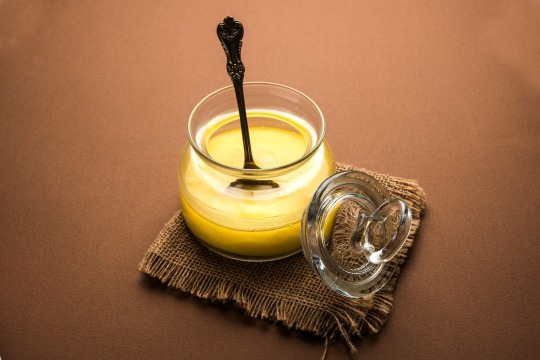
Maintaining the health of our gut lining is essential for overall digestive well-being and nutrient absorption. The gut lining, composed of a single layer of cells, plays a crucial role in preventing harmful substances from entering the bloodstream while allowing the absorption of essential nutrients. Organic A2 Ghee, with its butyric acid content, supports gut lining health by promoting the production of short-chain fatty acids that nourish the cells lining the intestine. This helps in maintaining the integrity of the gut barrier and reducing inflammation, ultimately contributing to a healthier gut environment.

Improved Gut Health

To enhance our overall digestive well-being and nutrient absorption, we focus on the benefits of improved gut health. Organic A2 Ghee plays a significant role in promoting a healthier gut environment. The butyric acid present in A2 Ghee supports gut lining health, potentially reducing gut inflammation and nurturing beneficial gut bacteria. By incorporating A2 Ghee into our diet, we can contribute to an overall improvement in gut health.
Maintaining a healthy gut is essential for proper digestion and overall wellness. The properties of A2 Ghee aid in smoother digestion processes, assisting in the breakdown of food through the enzymes present in its gastric juices. This, in turn, facilitates better digestion and nutrient absorption.
Adding A2 Ghee to meals can help optimize the digestive system’s functions, ensuring that we make the most of the nutrients we consume for our overall health and well-being.
Reviews for Raghas A2 Desi Ghee
In conclusion, incorporating organic A2 ghee into your diet can offer a range of digestive benefits. From easier digestion and reduced discomfort to enhanced nutrient absorption and a healthier gut environment, A2 ghee supports beneficial bacteria growth and reduces inflammation, promoting smoother digestion and overall well-being. By adding this nutritious and delicious ingredient to your meals, you can enjoy a happier and healthier gut.
For those seeking the highest quality A2 ghee, we recommend Raghas A2 Desi Ghee from www.raghasdairy.com. Raghas A2 Desi Ghee is crafted with care and precision, ensuring you receive the best of what nature has to offer. Start your journey to better digestive health today with Ragh’s A2 Desi Ghee.

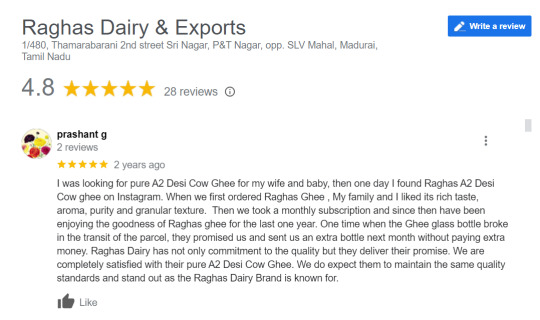
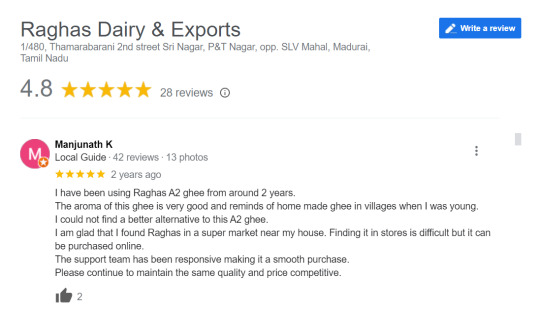
Frequently Asked Questions
Which Ghee Is Best for Digestion?
We find that ghee without A1 beta-casein protein is best for digestion. It aids in smoother digestion processes, supports nutrient absorption, and maintains a healthier gut. This type of ghee reduces the likelihood of digestive discomfort.
What Are the Benefits of A2 Ghee?
We find that A2 Ghee offers numerous benefits for digestion. It supports smoother digestion processes, aids in nutrient absorption, and promotes gut health. Its absence of A1 beta-casein protein makes it easier to digest, reducing discomfort.
What Is the Effect of Ghee on Digestion?
Ghee supports digestion by aiding nutrient absorption and promoting gut health. It can prevent discomfort and improve overall wellness. Its benefits include enhancing gut lining health, reducing inflammation, and nourishing beneficial bacteria for better gut health.
How to Consume A2 Ghee?
Let’s consume A2 ghee by adding it to hot beverages for creaminess, using it in cooking to enhance flavor, spreading it on toast or popcorn, incorporating it in baking recipes, and drizzling it over cooked meals for added nutrients.
1 note
·
View note